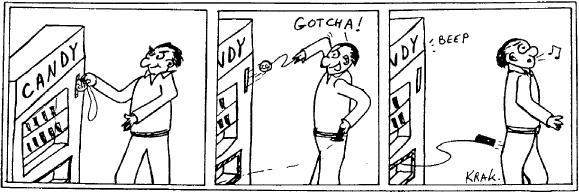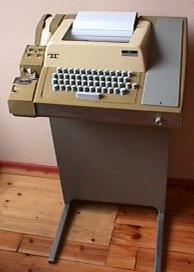  Gotcha! Cartoon by Larry Krakauer  Another incident involved a device I've mentioned before, an old-fashioned printing terminal called a "Teletype" (see a picture to the left). I discussed the operation of this machine, perhaps in excessive detail,
in a footnote to an earlier entry. For the purposes of this entry, suffice it to say that it was entirely mechanical, and its operation depended on a continuously rotating shaft in the bowels of the machine. As a result, it made a constant whirring noise whenever it was turned on.
I witnessed the following event in MIT's Artificial Intelligence lab, while I was a graduate student working on my Ph.D. thesis in the sixties. One morning, another graduate student I had never seen before walked into the Lab, and presented the assorted hackers and hangers-on with a piece of paper authorizing him to use our PDP-6 computer to analyze the results of some experiment he had apparently done. This piece of paper was signed by Professor Minsky, the head of the Lab. Since time on MIT's mainframe computer cost around $300 per hour, he thought he had performed a great feat in getting Professor Minsky to authorize the use of our machine. Actually, Minsky, a brilliant genius, and one of the great luminaries in the field of Artificial Intelligence, was quite impatient with administration and management, and would sign almost anything.
We had no idea exactly what program could be used to analyze his data. Type them into a spreadsheet, I hear you cry? Very funny. This was in the sixties. The first real spreadsheet, Visicalc, didn't appear until 1979, and Lotus 1-2-3 wasn't introduced until 1983, running on the IBM PC under DOS. Actually, there were very few programming languages available on our lab's PDP-6, only the MIDAS assembly language (basically, the language of the machine itself), and LISP, a high-level language often used in Artificial Intelligence research. We didn't even have a FORTRAN compiler. I once wrote a program to accomplish some simple task using the mathematical capabilities of TECO, our text editor. Note 1
Nevertheless, we figured the first step was to enter the data, and we could worry about how to analyze it later. So we sat the graduate student at a terminal, and showed him how to start entering his reams of data into the text editor. However, he seemed panicked by the machine, and kept asking for assurances that a typing error wouldn't break anything (an idea which was laughable to the programmers). The din from the old Teletype terminal we were using, whose worn main shaft bearings were beginning to rattle ominously, only added to his anxiety. Furthermore, someone had long since broken off the clear plastic part of the Teletype's cover, exposing the innards, and making it even noisier.
After our guest had been given his instructions, he was left alone at the terminal. He still seemed extremely nervous, and I kept an eye on him to see how he was doing. Eventually he got up the nerve to type his first key with one trembling finger. Unfortunately for his computing career, the venerable Teletype chose just that moment to go to the great keypunch room in the sky. With a monumental "BOINNNG" heard 'round the Lab, it actually threw a large chunk of metal straight up into the air, through the opening left by the broken top cover. As all heads spun around to watch, this fragment nearly reached the ceiling, appeared to hover momentarily, and then plunged back into the mechanism from whence it had come. At that point, the terminal terminal began to make horrible grinding noises, five people ran over to shut it off before it completely destroyed itself (they were too late), and the poor graduate student, complete horror etched on his face, ran out of the Lab, and was never seen again. He no doubt thought that his worst fears had come to pass - he had done something wrong, and broken our half-million-dollar computer.
Score for these two episodes: man 1, machine 1. Another incident involved a device I've mentioned before, an old-fashioned printing terminal called a "Teletype" (see a picture to the left). I discussed the operation of this machine, perhaps in excessive detail,
in a footnote to an earlier entry. For the purposes of this entry, suffice it to say that it was entirely mechanical, and its operation depended on a continuously rotating shaft in the bowels of the machine. As a result, it made a constant whirring noise whenever it was turned on.
I witnessed the following event in MIT's Artificial Intelligence lab, while I was a graduate student working on my Ph.D. thesis in the sixties. One morning, another graduate student I had never seen before walked into the Lab, and presented the assorted hackers and hangers-on with a piece of paper authorizing him to use our PDP-6 computer to analyze the results of some experiment he had apparently done. This piece of paper was signed by Professor Minsky, the head of the Lab. Since time on MIT's mainframe computer cost around $300 per hour, he thought he had performed a great feat in getting Professor Minsky to authorize the use of our machine. Actually, Minsky, a brilliant genius, and one of the great luminaries in the field of Artificial Intelligence, was quite impatient with administration and management, and would sign almost anything.
We had no idea exactly what program could be used to analyze his data. Type them into a spreadsheet, I hear you cry? Very funny. This was in the sixties. The first real spreadsheet, Visicalc, didn't appear until 1979, and Lotus 1-2-3 wasn't introduced until 1983, running on the IBM PC under DOS. Actually, there were very few programming languages available on our lab's PDP-6, only the MIDAS assembly language (basically, the language of the machine itself), and LISP, a high-level language often used in Artificial Intelligence research. We didn't even have a FORTRAN compiler. I once wrote a program to accomplish some simple task using the mathematical capabilities of TECO, our text editor. Note 1
Nevertheless, we figured the first step was to enter the data, and we could worry about how to analyze it later. So we sat the graduate student at a terminal, and showed him how to start entering his reams of data into the text editor. However, he seemed panicked by the machine, and kept asking for assurances that a typing error wouldn't break anything (an idea which was laughable to the programmers). The din from the old Teletype terminal we were using, whose worn main shaft bearings were beginning to rattle ominously, only added to his anxiety. Furthermore, someone had long since broken off the clear plastic part of the Teletype's cover, exposing the innards, and making it even noisier.
After our guest had been given his instructions, he was left alone at the terminal. He still seemed extremely nervous, and I kept an eye on him to see how he was doing. Eventually he got up the nerve to type his first key with one trembling finger. Unfortunately for his computing career, the venerable Teletype chose just that moment to go to the great keypunch room in the sky. With a monumental "BOINNNG" heard 'round the Lab, it actually threw a large chunk of metal straight up into the air, through the opening left by the broken top cover. As all heads spun around to watch, this fragment nearly reached the ceiling, appeared to hover momentarily, and then plunged back into the mechanism from whence it had come. At that point, the terminal terminal began to make horrible grinding noises, five people ran over to shut it off before it completely destroyed itself (they were too late), and the poor graduate student, complete horror etched on his face, ran out of the Lab, and was never seen again. He no doubt thought that his worst fears had come to pass - he had done something wrong, and broken our half-million-dollar computer.
Score for these two episodes: man 1, machine 1.
 The above two stories were originally printed in the eighties, in an in-house Kronos publication called the "Kronos Krier", put together by administrative assistant Vicky Ramsey when Kronos was a small startup. I wrote a column called "Krak's Korner of the Kronos Krier", and the logo used at the top of the page is shown to the right. Note that I had a bit more hair in those days, and a moustache.
The drawing used on the right side was made by copying a photograph on a xerographic copier, and copying the resulting image, and repeating this a few times. The copiers of that day were very bad at reproducing photos, and each copy gave the image greater and greater contrast, until it ended up essentially a line drawing. That's the sort of thing we did before Photoshop®. The large letters were hand drawn with a Rapidograph pen, using a lettering stencil. I drew the cartoon by hand in pencil, traced over it with a Rapidograph, and then erased the remaining pencil marks. The above two stories were originally printed in the eighties, in an in-house Kronos publication called the "Kronos Krier", put together by administrative assistant Vicky Ramsey when Kronos was a small startup. I wrote a column called "Krak's Korner of the Kronos Krier", and the logo used at the top of the page is shown to the right. Note that I had a bit more hair in those days, and a moustache.
The drawing used on the right side was made by copying a photograph on a xerographic copier, and copying the resulting image, and repeating this a few times. The copiers of that day were very bad at reproducing photos, and each copy gave the image greater and greater contrast, until it ended up essentially a line drawing. That's the sort of thing we did before Photoshop®. The large letters were hand drawn with a Rapidograph pen, using a lettering stencil. I drew the cartoon by hand in pencil, traced over it with a Rapidograph, and then erased the remaining pencil marks.
  Note 1: The name of the text editing program TECO was originally an acronym for Tape Editor and Corrector, where the "tape" referred to was punched paper tape. It was later thought of as meaning Text Editor and Corrector. It was actually a rather sophisticated program, with substantial capabilities as a programming language. The later, well-known EMACS editor was originally written in TECO (EMACS stood for Editing MACroS running on TECO). Years later, I used an editor that seemed to share many of its commands with TECO (I think it was VEDIT). I mentioned to Jack Rich, another programmer, that I wished I remembered more of the TECO commands, because they often seemed to work with VEDIT (if I could remember them, it would be easier than actually reading the manual). Jack said to me, "Just type them." "How can I type them, if I can't remember them?", I asked. He said, "Try it - just type them." The next time I wanted to do a search and replace, I vaguely remembered that you used angle brackets to iterate ("<...>"), so I started off with a "<". The next character was an "s", for "search", ... and then I just typed. The needed command string rolled off my fingers, a command string that I couldn't remember, but I could type - it was astonishing. And it worked. Jack Rich was also an accomplished pianist, and knew a lot about "muscle memory". It's very low level memory that lasts a long time. Like riding a bicycle, you don't forget it. [return to text] |